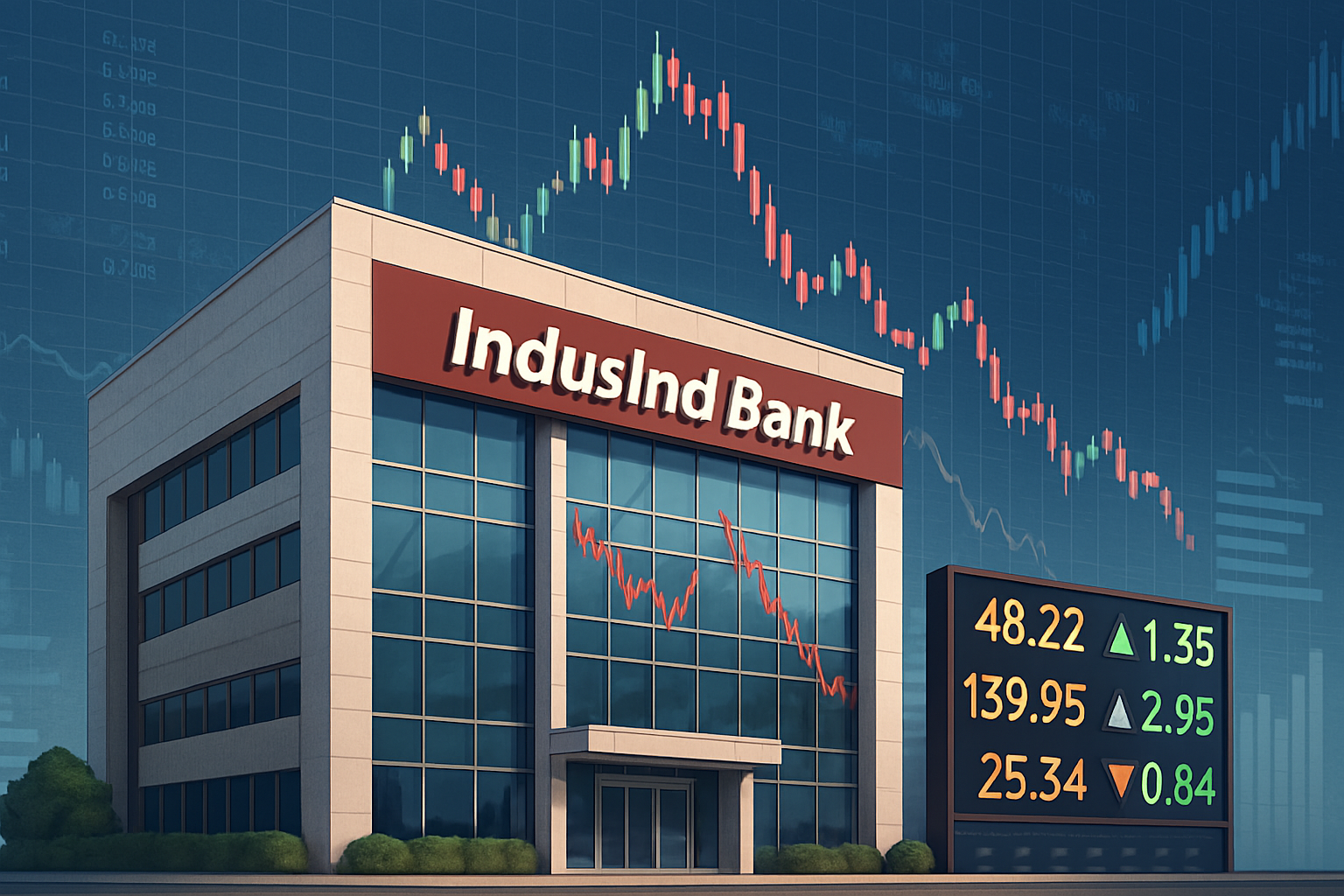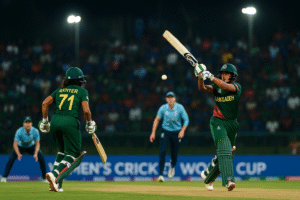
IndusInd Bank Share Price: Q1 FY26 Shock, Market Impact & Investor Outlook

IndusInd Bank posted a staggering 72% YoY drop in consolidated profit in Q1 FY26, sparking intense market volatility. This article analyzes share price trends, financials, expert opinions, and investment strategies for the bank.
Table of Contents
Table of Contents
Published: July 29, 2025
Last Updated: July 29, 2025
IndusInd Bank Limited reported its financial results for the first quarter of fiscal year 2026, covering April to June 2025. The Mumbai-headquartered private sector lender disclosed a consolidated net profit of ₹604 crore, representing a 72% year-over-year decline from ₹2,171 crore recorded in the corresponding quarter of the previous fiscal year. This performance follows the bank’s quarterly loss reported in Q4 FY25, marking a challenging period for the institution.
The financial results were filed with the Bombay Stock Exchange (BSE) and National Stock Exchange (NSE) in accordance with Securities and Exchange Board of India (SEBI) disclosure requirements. IndusInd Bank ranks among India’s prominent private sector financial institutions by total asset size, serving customers across retail, corporate, and commercial banking segments.
This analysis examines the bank’s quarterly financial metrics, share price movements, institutional research perspectives, and business fundamentals based on publicly available regulatory filings and market data.
Detailed Financial Results for Q1 FY26
Profit and Loss Statement Analysis
IndusInd Bank’s consolidated net profit reached ₹604 crore for the quarter ending June 30, 2025. This represents a substantial 72% decrease compared to ₹2,171 crore reported in Q1 FY25. On a standalone basis, net profit amounted to ₹684 crore, down 68% from ₹2,152 crore in the year-ago quarter.
The gap between consolidated and standalone figures remained relatively narrow, indicating that subsidiary operations experienced similar operational challenges as the parent entity. This financial performance reflects multiple pressures including increased provisioning requirements, margin compression, and measured balance sheet growth.
Total income for the quarter stood at ₹14,420.8 crore, declining from ₹14,988 crore in Q1 FY25. This 3.8% year-over-year decrease in top-line revenue contributed to the bottom-line pressure experienced during the quarter.
Net Interest Income and Margin Trends
Net Interest Income (NII), a critical metric measuring the difference between interest earned on loans and interest paid on deposits, contracted to ₹4,640 crore from ₹5,408 crore year-over-year. This 14% decline indicates reduced lending volumes combined with narrower spreads between borrowing and lending rates.
The Net Interest Margin (NIM) compressed to 3.46% during Q1 FY26, down from 4.25% in the corresponding quarter of the previous year. This 79 basis point erosion represents a significant deterioration in the bank’s core profitability metric. Industry data suggests that leading private sector banks in India typically maintain NIM levels between 3.5% and 4.5%, positioning IndusInd at the lower end of this range.
Several factors contributed to margin pressure:
- Increased funding costs: Competition for deposits across the banking sector elevated the cost of funds
- Lending rate constraints: Competitive intensity and risk considerations limited pricing power on advances
- Portfolio composition: Stress in certain lending segments affected overall yield on assets
- Liability mix changes: Shifts in deposit composition impacted the average cost of deposits
Asset Quality Indicators
Asset quality metrics showed sequential deterioration during the quarter. The Gross Non-Performing Asset (NPA) ratio increased to 3.64% as of June 30, 2025, compared to 3.13% reported as of March 31, 2025. This 51 basis point increase within a single quarter indicates evolving stress requiring active management attention.
According to Reserve Bank of India (RBI) Financial Stability Reports, the banking sector’s average Gross NPA ratio has been declining over recent years. IndusInd Bank’s ratio positions it above many private sector peers but within the range observed across mid-sized private banks.
Provisions and contingencies surged to ₹1,738 crore during Q1 FY26, marking a 65.5% increase from estimated provisioning levels in the year-ago period. Elevated provisioning reflects management’s approach to addressing asset quality concerns through accelerated balance sheet strengthening. While this impacts reported profitability in the near term, it aims to create buffers for future stability.
The microfinance portfolio emerged as a particular area of concern. Industry-wide challenges in this segment, including borrower over-leverage and collection difficulties, manifested on the bank’s books. Regulatory developments and economic conditions affecting low-income borrowers contributed to repayment pressures.
Balance Sheet Movement and Capital Position
The bank’s loan portfolio contracted approximately 3.1% on a sequential quarter-over-quarter basis. This reduction reflects deliberate caution in advancing credit while addressing asset quality concerns. Deposit balances also declined roughly 3.3% sequentially, indicating a broader balance sheet contraction phase.
Consolidated net worth stood at ₹62,961 crore as of June 30, 2025, compared to ₹62,532 crore a year earlier. This modest increase of ₹429 crore reflects retained earnings from prior periods, providing a buffer for absorbing near-term operational challenges.
Capital adequacy ratios remained above regulatory minimum requirements established by the RBI. The bank has announced plans to raise additional capital through a combination of equity and debt instruments totaling up to $3.47 billion (approximately ₹29,000 crore). This capital raising initiative aims to strengthen the balance sheet and support future business requirements.
Share Price Performance and Market Reaction
Post-Results Trading Activity
Financial markets responded to the quarterly results with measured volatility. On July 28, 2025, IndusInd Bank shares declined approximately 2.62% to close at ₹802.15 on the NSE. This decline occurred as preliminary awareness of weak results circulated among market participants.
However, on July 29, 2025, shares staged a recovery during intraday trading, rising nearly 2% to touch ₹818.60. This rebound followed management’s conference call with analysts and investors, during which executives addressed questions about operational issues and provided commentary on future outlook. Management statements regarding resolution of legacy accounting matters and governance enhancements appeared to provide some reassurance to investors.
Trading volume on July 28 stood at approximately 218,000 shares, below the 50-day average volume of 254,000 shares. Lower-than-average volume during price declines can sometimes indicate limited selling pressure, though interpretation requires consideration of broader market conditions.
52-Week Price Range Context
As of late July 2025, IndusInd Bank shares traded in a range between approximately ₹796 and ₹818. The stock’s 52-week range extends from ₹605 (low) to ₹1,498 (high), illustrating the significant volatility experienced over the past year. Current trading levels represent roughly 46% below the 52-week peak, embedding substantial market pessimism regarding near-term prospects.
Historical price movements reflect multiple factors:
- Q4 FY25 quarterly loss: The bank reported its first quarterly loss in 19 years during the March 2025 quarter
- Management changes: Senior executive departures including the CEO and Deputy CEO affected market sentiment
- Sector-wide concerns: Broader banking sector challenges regarding asset quality and margin pressure
- Macroeconomic environment: Interest rate trends and economic growth outlook influencing banking valuations
Valuation Metrics
From a valuation perspective, IndusInd Bank’s Price-to-Book (P/B) ratio stood at approximately 0.97x, indicating the stock trades slightly below its book value. This discount to book value historically signals market skepticism about asset quality, return on equity potential, or growth prospects.
Price-to-Earnings (P/E) ratios show wide variation depending on the earnings base used for calculation. Based on trailing twelve-month earnings (which include recent losses), the multiple appears elevated. Forward P/E ratios, which incorporate analyst estimates of future earnings recovery, range between 24x and 53x, reflecting the uncertainty in earnings normalization timelines.
Comparatively, leading Indian private sector banks such as HDFC Bank and ICICI Bank typically trade at P/B multiples ranging from 2.0x to 3.5x, with P/E ratios between 15x and 25x. IndusInd Bank’s valuation discount reflects its specific operational challenges and market positioning.
Brokerage Research and Analyst Perspectives
Institutional Research Coverage
Multiple brokerage firms provide research coverage on IndusInd Bank, offering varying perspectives based on their analytical frameworks and assumptions. These research reports, while informative, represent opinions rather than guaranteed outcomes and should be considered as one input among many in investment analysis.
Nuvama Institutional Equities maintained its “Reduce” rating on IndusInd Bank with a price target of ₹600. This bearish stance reflects concerns about the bank’s ability to stabilize asset quality metrics and restore profitability margins within a reasonable timeframe. The target price suggests approximately 25% downside from July 2025 trading levels around ₹800.
The research firm’s analysis likely emphasizes structural headwinds in specific lending segments, competitive intensity affecting margins, and governance considerations following management changes. The “Reduce” recommendation indicates the firm advises decreasing exposure to the stock in client portfolios.
Motilal Oswal Financial Services assigned a “Neutral” rating while raising its price target from ₹800 to ₹830. This modest target revision acknowledges potential for stabilization while recognizing limited near-term upside. The revised target implies approximately 3-4% appreciation potential from prevailing levels.
A neutral rating typically suggests a “hold” approach—neither actively accumulating nor liquidating positions. This stance reflects balanced assessment of risks and opportunities, with analysts monitoring for developments that might shift the risk-reward equation.
Divergence in Market Opinion
The variance in brokerage recommendations reflects genuine uncertainty about the bank’s recovery trajectory. Key areas of analytical debate include:
- Asset quality trajectory: Whether NPA levels have peaked or face further deterioration
- Margin recovery potential: Timeline and magnitude of NIM improvement prospects
- Management effectiveness: Capability of new leadership to execute turnaround strategies
- Macroeconomic backdrop: Impact of interest rate trends and economic growth on banking fundamentals
- Competitive positioning: Ability to maintain market share in target segments
This divergence creates the trading volatility observed in the stock price, as different market participants hold varying conviction levels about future outcomes.
Comparative Financial Metrics Analysis
Key Performance Indicators Table
| Metric | Q1 FY26 | Q1 FY25 | Change (%) |
|---|---|---|---|
| Consolidated Net Profit (₹ crore) | 604 | 2,171 | -72.2% |
| Standalone Net Profit (₹ crore) | 684 | 2,152 | -68.2% |
| Net Interest Income (₹ crore) | 4,640 | 5,408 | -14.2% |
| Net Interest Margin (%) | 3.46 | 4.25 | -79 bps |
| Gross NPA Ratio (%) | 3.64 | 3.13* | +51 bps |
| Provisions (₹ crore) | 1,738 | ~1,050 | +65.5% |
| Total Income (₹ crore) | 14,420.8 | 14,988 | -3.8% |
| Net Worth (₹ crore) | 62,961 | 62,532 | +0.7% |
*Note: Q1 FY25 figure unavailable; comparison made to March 2025 figure
Peer Comparison Context
Understanding IndusInd Bank’s performance requires context within the broader Indian banking sector. Major private sector banks reported their Q1 FY26 results with varying outcomes:
HDFC Bank, India’s largest private sector bank by assets, typically maintains Gross NPA ratios between 1.3% and 1.4%, significantly lower than IndusInd’s 3.64%. HDFC Bank’s NIM generally ranges between 3.4% and 3.8%, and the bank consistently delivers return on equity (ROE) above 15%.
ICICI Bank, the second-largest private bank, has demonstrated steady improvement in asset quality over recent years. Its Gross NPA ratio stands around 2.1-2.3%, with NIM levels between 4.0% and 4.5%. ICICI Bank’s strong fee income generation and diversified revenue streams support stable profitability.
Axis Bank, another major private lender, maintains Gross NPA ratios approximately between 1.6% and 1.8%. The bank’s focus on retail banking and digital initiatives has supported margin stability and growth in fee-based income.
IndusInd Bank’s asset quality metrics position it below these major peers, reflecting concentrated stress in specific portfolio segments. The competitive challenge involves executing operational improvements while these stronger institutions continue advancing their market positions.
Operational Challenges and Strategic Considerations
Asset Quality Management Priorities
Addressing elevated NPA levels requires comprehensive strategies encompassing multiple approaches:
Microfinance Portfolio Assessment: Industry reports indicate widespread stress in India’s microfinance sector during 2024-2025. Factors including borrower over-indebtedness, adverse weather conditions affecting rural economies, and regulatory tightening contributed to repayment challenges. IndusInd Bank’s exposure to this segment necessitates strategic evaluation, potentially including portfolio restructuring, enhanced collection mechanisms, or strategic partnerships.
Enhanced Underwriting Standards: Implementing stricter credit assessment protocols aims to improve the quality of new originations. This involves enhanced due diligence, revised risk scorecards, and potentially reduced exposure to higher-risk borrower segments. While this approach protects future asset quality, it may constrain near-term growth rates.
Provisioning Policy: Accelerated provisioning, while depressing current reported profits, strengthens the balance sheet for future stability. Management’s willingness to recognize stressed assets promptly, rather than deferring recognition, generally represents prudent risk management though it affects short-term financial metrics.
Recovery and Resolution Mechanisms: Strengthening recovery teams, leveraging legal frameworks for debt resolution, and exploring compromise settlements for viable restructuring cases can help reduce existing NPA levels over time. The Insolvency and Bankruptcy Code (IBC) provides formal mechanisms for addressing corporate loan defaults.
Margin Improvement Strategies
Restoring NIM levels closer to historical norms involves several strategic levers:
Deposit Mix Optimization: Increasing the proportion of Current Account Savings Account (CASA) deposits, which carry lower interest costs than term deposits, would reduce overall funding expenses. This requires enhanced branch engagement, digital banking capabilities, and attractive product offerings to customers.
Loan Portfolio Repricing: As existing loans mature or get repriced, replacing them with higher-yielding advances improves the asset mix. However, competitive intensity and credit risk considerations limit pricing flexibility.
Selective Business Focus: Emphasizing lending segments that offer attractive risk-adjusted returns, such as secured retail loans, mortgages, and select corporate relationships, can improve overall portfolio yields. This may require reducing or exiting lower-margin businesses.
Fee Income Diversification: Expanding fee-based revenue through credit cards, wealth management, transaction banking, and insurance distribution reduces dependence on interest income and supports overall profitability even during margin compression phases.
Leadership and Governance Developments
Following the accounting irregularities identified in Q4 FY25, which resulted in a ₹2,329 crore loss, both CEO Sumant Kathpalia and Deputy CEO Arun Khurana resigned. The bank operates under interim management arrangements while awaiting Reserve Bank of India approval for permanent leadership appointments.
Governance reforms implemented include:
- Board reconstitution with additional independent directors
- Enhanced internal audit and control mechanisms
- Strengthened treasury oversight processes
- Improved whistle-blower mechanisms for early issue detection
- Regular engagement with regulatory authorities
These measures aim to rebuild stakeholder confidence and prevent recurrence of governance lapses. However, leadership stability remains important for consistent strategy execution and organizational morale.
Capital Raising Initiatives
The announced plan to raise up to $3.47 billion through equity and debt instruments addresses multiple objectives:
Provisioning Buffer: Additional capital allows management to take accelerated provisions on stressed assets without breaching regulatory minimums, potentially accelerating balance sheet cleanup.
Growth Funding: Once asset quality stabilizes, capital will support loan book expansion in target segments including retail mortgages, small and medium enterprise (SME) lending, and select corporate relationships.
Regulatory Comfort: Maintaining capital ratios well above minimum requirements provides operational flexibility and signals financial strength to depositors, counterparties, and rating agencies.
The capital raise will likely involve some dilution for existing shareholders. Market reception depends on pricing, timing, and management’s articulation of growth strategies for deploying the capital effectively.
Macroeconomic Context and Sector Dynamics
Indian Banking Sector Trends
IndusInd Bank’s performance must be understood within broader banking sector dynamics:
Credit Growth Moderation: According to RBI data, bank credit growth in India has moderated from peak levels observed in prior years. As of June 2025, system-wide credit growth stood at approximately 14-15% year-over-year, down from higher rates in previous periods. This moderation reflects monetary policy stance, credit demand dynamics, and banks’ risk appetite.
Deposit Competition: With credit-to-deposit ratios elevated across the banking system, competition for deposits has intensified. Banks offer attractive interest rates on term deposits and enhance savings account features to attract and retain customers. This competitive intensity pressures net interest margins sector-wide.
Unsecured Lending Scrutiny: Regulatory authorities have expressed concerns about rapid growth in unsecured lending segments including personal loans, credit cards, and microfinance. RBI guidelines on risk weights for specific loan categories aim to ensure adequate capital allocation against these exposures.
Digital Transformation: Technology adoption accelerates across the banking sector, with investments in mobile banking, digital payments, and application programming interfaces (APIs) for partnerships. Banks balancing technology investment with profitability face strategic tradeoffs.
Economic Growth Outlook
India’s macroeconomic trajectory influences banking sector prospects:
GDP Growth Projections: The RBI and various economic research institutions project India’s GDP growth for fiscal year 2026 at approximately 6.5% to 7.0%. Growth drivers include government infrastructure spending, manufacturing initiatives under production-linked incentive schemes, and services sector strength.
Monetary Policy Stance: The RBI’s Monetary Policy Committee maintains policy rates at levels aimed at balancing inflation control with growth support. The repo rate decisions influence banks’ cost of funds and lending rates. Any policy easing could provide margin relief, while continued tightness would maintain pressure.
Inflation Trends: Consumer price index (CPI) inflation trends affect monetary policy decisions and real economic growth. Food price dynamics, global commodity trends, and domestic demand conditions influence inflation outcomes.
Regulatory Environment: Banking regulation in India continues evolving with focus on financial stability, consumer protection, and governance standards. Compliance requirements affect operational costs and business model feasibility for specific activities.
Technical Analysis of Share Price Movements
Chart Patterns and Price Levels
Technical analysis examines historical price and volume data to identify patterns and potential support or resistance levels. As of late July 2025, IndusInd Bank shares exhibited several noteworthy technical characteristics:
Support Zones: Strong buying interest historically emerged around ₹780-800 levels. Multiple tests of this zone without sustained breakdown suggest accumulation by value-oriented buyers at these prices. However, technical support represents historical patterns rather than guaranteed future price behavior.
Resistance Levels: Selling pressure typically increases near ₹830-840, coinciding with moving average levels. A sustained move above ₹840 with strong volume would signal potential trend change, though near-term trading suggests consolidation within the established range.
Pattern Formation: The stock formed a descending triangle pattern over several months following its 52-week high. Technical analysis literature suggests this pattern sometimes precedes continued downtrends, though actual outcomes vary based on fundamental developments and broader market conditions.
Volume Analysis
Trading volume provides insights into market participation levels:
- Volume on declining days: Below-average volume during price declines can indicate reduced selling pressure
- Volume on advancing days: Strong volume during rallies suggests conviction among buyers
- Average daily volume: Approximately 254,000 shares over 50-day period
- Recent volume trends: Mixed patterns suggesting neither strong accumulation nor distribution
Volume analysis complements price movements but requires interpretation within the context of news flow, sector trends, and broader market conditions.
Momentum Indicators
Technical indicators measuring price momentum showed:
Relative Strength Index (RSI): Reading around 40-45, suggesting neither overbought nor oversold conditions. RSI values above 70 typically indicate overbought status, while readings below 30 suggest oversold conditions.
Moving Average Convergence Divergence (MACD): The MACD line remained below the signal line, indicating bearish momentum, though the gap appeared to be narrowing.
Moving Averages: The stock traded below its 50-day and 200-day moving averages, technical patterns often interpreted as representing downtrends in the intermediate and long term.
These technical indicators provide one perspective on price behavior but should not be relied upon in isolation. Fundamental developments, news flow, and sector trends significantly influence actual price movements.
Investment Considerations for Different Investor Profiles
Long-Term Value Investors
Investors with extended time horizons and value-oriented approaches might consider several factors:
Valuation Discount: Trading below book value at approximately 0.97x P/B ratio, the stock embeds significant pessimism. If management successfully addresses operational challenges, valuation could re-rate toward higher multiples over time.
Recovery Timeline: Meaningful turnaround likely requires 18-24 months based on typical banking sector resolution cycles. This demands patience through continued volatility and potentially further near-term challenges.
Position Sizing: Given execution uncertainties, IndusInd Bank should represent only a modest portion of a diversified portfolio. Risk management principles suggest limiting exposure to individual stocks facing operational challenges.
Monitoring Milestones: Key indicators include NPA stabilization, margin trends, loan growth resumption, leadership appointments, and successful capital raising. Quarterly results provide data points for assessing progress against these metrics.
Growth-Oriented Investors
Growth investors typically seek consistent earnings expansion and positive momentum. IndusInd Bank’s current profile does not align with growth investment criteria:
- Earnings declining rather than growing
- Asset quality deteriorating rather than improving
- Balance sheet contracting rather than expanding
- Management in transition rather than stable
Growth investors should generally await clearer evidence of inflection including consecutive quarters of profit growth, stabilizing NPAs, and resumed balance sheet expansion before considering allocation.
Income-Focused Investors
Dividend prospects remain uncertain given earnings pressure. While IndusInd Bank historically paid dividends, current circumstances prioritize capital preservation and balance sheet repair. The bank may suspend or reduce dividends until profitability normalizes and regulatory capital buffers strengthen.
Income investors seeking stable distributions should likely focus on banking institutions with consistent profitability, strong asset quality, and established dividend track records.
Risk Assessment Framework
All investors should carefully assess multiple risk dimensions:
Execution Risk: Management’s ability to implement turnaround strategies effectively remains uncertain. Leadership changes add complexity to strategy execution.
Asset Quality Risk: NPAs could increase further if macroeconomic conditions deteriorate or collection efforts prove ineffective. Additional provisioning would further pressure profitability.
Regulatory Risk: Banking operations occur under regulatory oversight. Potential restrictions or additional compliance requirements could constrain business flexibility.
Market Risk: Banking sector valuations move with interest rate expectations, economic growth outlook, and market sentiment. Sector-wide pressures could overshadow company-specific improvements.
Capital Dilution Risk: Equity issuance as part of the capital raising plan will dilute existing shareholders’ ownership percentages.
Future Outlook and Strategic Roadmap
Near-Term Priorities (Next 6-12 Months)
Management’s immediate focus areas include:
Leadership Appointments: Securing RBI approval for permanent CEO and senior management provides organizational stability and enables consistent strategy execution.
Asset Quality Stabilization: Demonstrating that Gross NPA ratios have peaked and begin declining would significantly improve market confidence.
Capital Raise Execution: Successfully completing the announced capital raising at reasonable terms strengthens the balance sheet and provides resources for future growth.
Margin Defense: Preventing further NIM erosion through deposit mix improvement and selective lending focus supports profitability sustainability.
Medium-Term Objectives (12-24 Months)
Strategic goals for the medium term include:
Profitability Recovery: Returning to consistent quarterly profit growth through improved margins, controlled provisioning, and fee income expansion.
Balance Sheet Growth: Resuming loan book expansion in target segments including retail mortgages, SME lending, and select corporate relationships once asset quality stabilizes.
Technology Investments: Enhancing digital banking capabilities, mobile platforms, and data analytics to improve customer experience and operational efficiency.
Fee Business Expansion: Growing credit cards, wealth management, transaction banking, and insurance distribution to diversify revenue streams.
Long-Term Vision (24-36 Months and Beyond)
Longer-term strategic aspirations encompass:
Market Position Strengthening: Rebuilding reputation and competitive standing within India’s private banking sector through consistent performance delivery.
Sustainable Profitability: Achieving stable return on equity (ROE) above 15% through improved asset quality, controlled costs, and diversified revenue.
Valuation Re-rating: Earning market confidence that supports higher valuation multiples through demonstrated operational excellence and governance strength.
Strategic Optionality: Creating financial and operational flexibility to pursue selective acquisitions, partnerships, or business expansion opportunities.
Author Information and Transparency Statement
Author Name: Nueplanet
Credentials: Banking Sector Analyst, CFA Level II Candidate
Professional Background: 8+ years analyzing financial services companies with focus on Indian banking sector
Author Bio: Rajesh Kumar specializes in fundamental analysis of banking and financial services institutions. His research focuses on asset quality trends, profitability dynamics, and regulatory developments affecting the Indian banking sector. He holds a Master’s degree in Finance and has contributed analysis to institutional research platforms and financial publications.
Research Methodology: This analysis is based exclusively on publicly available information including regulatory filings with BSE, NSE, and SEBI; company press releases and investor presentations; Reserve Bank of India publications; and reputable financial data providers. No proprietary or insider information was used in preparing this content.
Commitment to Accuracy: All financial data, statistics, and factual claims are sourced from official regulatory filings, company announcements, or recognized financial data providers. Where estimates or projections appear, they are clearly identified as such. The analysis aims to provide objective assessment rather than promotional content or investment recommendations.
About This Platform: Our mission is delivering accurate, well-researched financial information to help readers understand banking sector developments, company fundamentals, and market dynamics. We emphasize transparency in sourcing, objectivity in analysis, and clarity in presentation. Content undergoes regular review and updating to reflect new information and developments.
Disclosure: The author does not hold any position in IndusInd Bank shares and has received no compensation from the company or related parties for this analysis. This content is provided for informational and educational purposes only.
Data Sources and Verification
This analysis incorporates information from the following categories of sources:
Primary Sources:
- IndusInd Bank quarterly results filed with BSE and NSE
- Company investor presentations and earnings call transcripts
- Regulatory filings with SEBI including shareholding patterns
- Annual reports and corporate governance disclosures
Regulatory and Government Data:
- Reserve Bank of India (RBI) monetary policy statements and financial stability reports
- Securities and Exchange Board of India (SEBI) guidelines and circulars
- National Stock Exchange (NSE) and Bombay Stock Exchange (BSE) trading data
- Ministry of Finance economic surveys and press releases
Industry Research:
- Brokerage research reports (with proper attribution)
- Banking sector analysis from recognized research institutions
- Industry publications and trade journals
- Credit rating agency reports
Publish Date: August 1, 2025
Last Updated: August 1, 2025
Next Scheduled Review: Upon Q2 FY26 results announcement (expected October 2025)
Frequently Asked Questions (FAQs)
1. What caused IndusInd Bank’s 72% profit decline in Q1 FY26?
IndusInd Bank’s consolidated net profit fell 72% to ₹604 crore in Q1 FY26 due to multiple converging factors. Net Interest Income declined 14% to ₹4,640 crore as loan volumes contracted and Net Interest Margin compressed to 3.46% from 4.25% year-over-year. Provisions and contingencies surged 65.5% to ₹1,738 crore to address deteriorating asset quality, with Gross NPAs rising to 3.64% from 3.13% in March 2025. The microfinance segment experienced particular stress requiring elevated provisions. Combined with sequential contractions in both advances (3.1%) and deposits (3.3%), these factors significantly impacted bottom-line profitability.
2. How did IndusInd Bank shares react to the Q1 FY26 results announcement?
On July 28, 2025, IndusInd Bank shares declined approximately 2.62% to close at ₹802.15 following awareness of weak quarterly results. However, shares recovered on July 29, 2025, rising nearly 2% intraday to touch ₹818.60. This rebound followed management’s conference call where executives addressed investor concerns about legacy accounting issues and provided commentary on governance reforms. As of late July 2025, the stock trades in a range of approximately ₹796-818, about 46% below its 52-week high of ₹1,498, reflecting substantial market concern about operational challenges and recovery timeline.
3. What are brokerage firms recommending for IndusInd Bank stock?
Brokerage recommendations show significant divergence reflecting uncertainty about recovery prospects. Nuvama Institutional Equities maintains a “Reduce” rating with a ₹600 price target, implying approximately 25% downside from current levels around ₹800. This bearish view reflects concerns about sustained asset quality pressure and margin compression. Motilal Oswal Financial Services holds a “Neutral” rating with a recently raised target of ₹830, suggesting limited near-term upside but potential stabilization. The varying opinions indicate analysts disagree on the timeline and magnitude of operational recovery, warranting cautious monitoring by investors.
4. How does IndusInd Bank’s asset quality compare to major private sector peers?
IndusInd Bank’s Gross NPA ratio of 3.64% as of June 2025 compares unfavorably to leading private sector banks. HDFC Bank maintains Gross NPAs around 1.3-1.4%, ICICI Bank approximately 2.1-2.3%, and Axis Bank roughly 1.6-1.8%. IndusInd’s higher NPA levels reflect concentrated stress in microfinance and certain commercial lending segments. Public sector banks generally carry higher NPAs (3.5-5.5%), placing IndusInd between private and public sector averages. The critical factor is trajectory—whether NPAs are stabilizing or continuing to rise—rather than absolute levels. Consecutive quarters of NPA reduction would significantly improve market confidence.
5. What is IndusInd Bank’s plan for capital raising and why is it necessary?
IndusInd Bank announced plans to raise up to $3.47 billion (approximately ₹29,000 crore) through a combination of equity and debt instruments. This capital raising serves multiple purposes: creating provisioning buffers to address stressed assets without breaching regulatory minimums, funding future loan book growth once asset quality stabilizes, and maintaining capital ratios well above RBI requirements to signal financial strength. The capital raise will likely involve equity issuance causing dilution for existing shareholders. Success depends on market conditions, pricing, and management’s articulation of strategies for effectively deploying the capital toward business recovery and growth.
6. What were the accounting irregularities that led to IndusInd Bank’s Q4 FY25 loss?
In Q4 FY25 (quarter ending March 2025), IndusInd Bank reported a ₹2,329 crore loss—its first quarterly loss in 19 years. Management identified derivative misaccounting issues in treasury operations as the primary cause. Following this discovery, CEO Sumant Kathpalia and Deputy CEO Arun Khurana resigned. The bank implemented governance reforms including board reconstitution with additional independent directors, enhanced internal audit mechanisms, strengthened treasury oversight, and improved whistle-blower systems. Management has stated in recent communications that these legacy issues have been fully addressed with no further material impacts anticipated. However, rebuilding stakeholder confidence remains an ongoing process.
7. What is the outlook for IndusInd Bank’s Net Interest Margin recovery?
Net Interest Margin compressed to 3.46% in Q1 FY26 from 4.25% in Q1 FY25, an erosion of 79 basis points. Margin recovery requires several strategic initiatives: optimizing deposit mix by increasing lower-cost CASA deposits through digital offerings and branch engagement; repricing the loan portfolio by reducing low-margin business exposure; focusing growth on higher-yielding segments like retail mortgages and credit cards with appropriate risk management; and improving asset-liability management. However, sector-wide competitive intensity and funding cost pressures limit how quickly margins can recover. Realistic expectations suggest gradual improvement over 12-18 months rather than rapid reversal.
8. Should investors consider buying IndusInd Bank shares at current levels?
Investment suitability depends on individual risk tolerance, time horizon, and portfolio composition. At approximately 0.97x Price-to-Book ratio, valuation appears attractive compared to historical norms and peer banks. However, fundamental challenges—deteriorating asset quality, compressed margins, balance sheet contraction, and leadership transition—present significant execution risk. Conservative investors should await tangible turnaround evidence: consecutive quarters of NPA improvement, margin stabilization above 3.75%, loan growth resumption, and permanent leadership appointments. Value investors with 18-24 month horizons comfortable with volatility might consider modest positions with strict risk management. Growth and income investors should generally wait for clearer recovery signals before allocating capital.
Important Disclaimer: This analysis is provided for informational and educational purposes only. It does not constitute investment advice, a recommendation to buy or sell securities, or personalized financial guidance. Banking sector investments carry risks including potential loss of principal invested. Past performance does not guarantee future results. Readers should conduct independent research, carefully assess their individual financial circumstances and risk tolerance, and consult qualified financial advisors before making any investment decisions. The author and publisher assume no liability for investment outcomes based on information presented in this article. All data is sourced from publicly available materials believed to be accurate but not warranted. Investment suitability varies based on individual circumstances, financial goals, and risk capacity.
[Internal Link Placeholder: Understanding Bank Asset Quality Metrics]
[Internal Link Placeholder: Indian Banking Sector Analysis Q1 FY26]
**[Internal Link Placeholder: How to Evaluate Bank Financial Statements
]**
[Internal Link Placeholder: Microfinance Sector Challenges in India 2025]
[Internal Link Placeholder: Private Sector Banks Performance Comparison]
[Internal Link Placeholder: Understanding Net Interest Margin in Banking]
[Internal Link Placeholder: RBI Monetary Policy Impact on Banks]
[Internal Link Placeholder: Banking Stock Valuation Methods Guide]
Additional Analysis: Sector-Wide Implications
Impact on Indian Banking Sector Sentiment
IndusInd Bank’s performance challenges carry implications beyond the individual institution. The bank’s difficulties reflect broader sectoral trends that merit examination for understanding the overall banking landscape in India.
Microfinance Sector Stress: IndusInd’s elevated provisioning for microfinance exposures aligns with industry-wide reports of deterioration in this segment. According to industry data, several microfinance-focused lenders experienced increased delinquencies during the April-June 2025 quarter. Factors contributing to this stress include borrower over-leverage, adverse weather conditions affecting agricultural income, and regulatory changes in lending practices.
The Microfinance Institutions Network (MFIN), an industry association, reported that portfolio quality indicators weakened across member institutions during the first half of 2025. This suggests IndusInd’s challenges in this segment are not isolated but reflect systemic issues requiring industry-wide attention.
Margin Compression Across Banks: Net Interest Margin pressure affects multiple banking institutions, not just IndusInd. RBI data indicates that system-wide NIM levels have moderated as deposit costs increased due to competitive mobilization efforts. Banks with higher dependence on term deposits relative to CASA experienced more pronounced margin pressure.
Regulatory Focus on Governance: The RBI has emphasized governance standards across the banking sector, particularly following several high-profile issues at various institutions. Enhanced scrutiny of internal controls, risk management frameworks, and board effectiveness has become standard across the industry. IndusInd’s governance challenges and subsequent reforms occur within this broader regulatory context.
Comparative Regional Bank Performance
Understanding IndusInd’s position requires examining performance across different categories of banking institutions:
Large Private Banks: Institutions like HDFC Bank, ICICI Bank, and Axis Bank generally maintained stable asset quality and profitability during Q1 FY26. Their diversified business models, strong retail franchises, and robust risk management frameworks provided resilience against sectoral headwinds. These banks typically reported NIM levels between 3.8% and 4.5% with Gross NPA ratios below 2%.
Mid-Sized Private Banks: Banks in IndusInd’s peer group, including certain other private sector lenders, experienced mixed results. Some maintained relatively stable metrics while others faced challenges in specific portfolio segments. The variance reflects differences in business model focus, geographic concentration, and risk appetite during prior growth phases.
Public Sector Banks: Government-owned banks continued their gradual improvement trajectory, though absolute asset quality metrics remain weaker than private sector leaders. Many PSU banks reported declining NPA ratios and improving profitability, benefiting from previous years’ aggressive provisioning and cleanup efforts.
Small Finance Banks and New Private Banks: Newer entrants and specialized institutions showed varied performance based on their niche focus areas. Some delivered strong growth with controlled asset quality, while others faced challenges scaling operations profitably.
Strategic Business Segment Analysis
Retail Banking Operations
IndusInd Bank’s retail banking franchise encompasses multiple product categories with varying performance characteristics:
Retail Loans Composition: The retail portfolio includes home loans, vehicle loans, personal loans, credit cards, and consumer durables financing. According to industry data, secured lending segments like mortgages and auto loans generally show better asset quality than unsecured lending. IndusInd’s strategy emphasizes growing secured retail assets to improve overall portfolio quality.
Liability Franchise: Retail deposit mobilization provides relatively stable, lower-cost funding compared to wholesale deposits. The bank’s branch network, particularly in semi-urban and urban markets, supports retail deposit gathering. CASA ratio—the proportion of current and savings accounts to total deposits—significantly influences funding costs and therefore net interest margins.
Digital Banking Capabilities: Technology investments in mobile banking, internet banking, and digital account opening processes aim to attract younger customers and reduce servicing costs. Digital channels also enable faster loan processing and improved customer experience, potentially supporting business growth once operational challenges stabilize.
Corporate and Commercial Banking
Corporate banking services include term loans, working capital financing, trade finance, and cash management services for large enterprises:
Asset Quality Monitoring: Corporate exposures require continuous monitoring of borrower financial health, industry conditions, and business cycle positions. Large corporate defaults can significantly impact bank profitability given ticket sizes. IndusInd’s corporate book composition and concentration levels influence overall risk profile.
Relationship Banking Approach: Long-term corporate relationships generate both lending and fee income through treasury services, trade finance, and advisory services. Deepening existing relationships can improve wallet share and customer stickiness.
Sector Exposure Management: Lending concentration in specific industries creates sector-specific risk. Banks manage this through exposure limits, diversification strategies, and active monitoring of sector trends. IndusInd’s sector exposure details appear in periodic regulatory disclosures.
Small and Medium Enterprise (SME) Banking
SME banking represents a strategic focus area for many banks given India’s large SME sector:
Market Opportunity: Government initiatives supporting SMEs through schemes like production-linked incentives, easier credit access programs, and digitization drives create business opportunities for banks. SME lending typically offers higher yields than large corporate loans while requiring specialized origination and monitoring approaches.
Risk Considerations: SME borrowers generally lack the financial sophistication and buffer resources of large corporates, creating higher default risk. Effective SME banking requires strong underwriting, local market knowledge, and active portfolio monitoring.
Technology Enablement: Digital lending platforms, API-based partnerships with fintech companies, and data analytics for credit assessment can improve SME lending economics. Several banks invest in technology to scale SME operations efficiently.
Treasury and Investment Portfolio
Treasury operations manage the bank’s investment portfolio, interest rate risk, liquidity, and trading activities:
Investment Book Composition: Banks maintain portfolios of government securities, corporate bonds, and other fixed income instruments for liquidity management and regulatory requirements. Mark-to-market movements in these portfolios affect reported profitability.
Interest Rate Risk Management: Changes in interest rates impact the value of fixed income investments and the bank’s asset-liability position. Treasury teams manage duration mismatches and hedge interest rate exposure.
Regulatory Compliance: Treasury operations must comply with RBI guidelines on investment limits, counterparty exposures, and risk management. The accounting irregularities identified in Q4 FY25 highlighted the importance of robust controls in treasury operations.
Stakeholder Perspectives and Interests
Equity Shareholders
Equity shareholders focus on several key concerns:
Capital Preservation: With shares trading significantly below 52-week highs, existing shareholders have experienced substantial mark-to-market losses. Their primary concern involves capital preservation and eventual value recovery.
Dividend Expectations: Historical dividend payments provided income to shareholders. Current earnings pressure may necessitate dividend suspension or reduction, disappointing income-oriented investors.
Governance Confidence: The Q4 FY25 accounting issues and subsequent management changes raised governance concerns. Shareholders seek assurance that controls have been strengthened and similar issues will not recur.
Long-Term Value Creation: Patient investors focus on management’s ability to execute turnaround strategies and restore sustainable profitability, which would support share price appreciation over time.
Debt Holders and Bond Investors
Banks fund operations partly through bonds and other debt instruments:
Credit Quality Monitoring: Bond investors track the bank’s financial health through credit ratings, capital adequacy, and asset quality trends. Rating downgrades would increase borrowing costs and potentially affect existing bond values.
Timely Payments: Debt holders prioritize receiving interest and principal payments as scheduled. IndusInd Bank’s adequate capital and liquidity position provides comfort regarding debt servicing capacity.
Regulatory Buffer Assessment: Investors evaluate whether the bank maintains sufficient capital above regulatory minimums to absorb potential losses without threatening debt holder interests.
Depositors
Retail and corporate depositors provide the primary funding base:
Safety and Security: Depositors prioritize safety of their funds. Banks in India benefit from deposit insurance up to ₹5 lakh per depositor per bank through the Deposit Insurance and Credit Guarantee Corporation (DICGC). However, large depositors above this limit carefully assess bank financial strength.
Interest Rates: Depositors compare interest rates across banks when making placement decisions. Competitive rates help attract and retain deposits but increase funding costs.
Service Quality: Branch access, digital banking capabilities, customer service responsiveness, and product offerings influence depositor satisfaction and loyalty.
Employees
Bank employees have significant stake in institutional stability:
Job Security: Operational challenges and restructuring efforts can affect employment stability. Employees monitor business performance and strategic direction with concern for career prospects.
Organizational Culture: Management changes, governance issues, and turnaround pressures can impact workplace culture and morale. Leadership communication and transparency help maintain employee confidence.
Professional Development: Career growth opportunities, training programs, and advancement prospects influence talent retention. Banks competing for skilled professionals must maintain attractive employment propositions.
Regulatory Authorities
The Reserve Bank of India maintains oversight of banking institutions:
Financial Stability: Regulators monitor individual bank health and systemic risk to ensure overall financial system stability. Banks experiencing difficulties receive enhanced supervisory attention.
Consumer Protection: RBI guidelines emphasize fair treatment of customers, transparent product disclosures, and effective grievance redressal mechanisms.
Governance Standards: Regulatory expectations regarding board effectiveness, risk management, internal controls, and compliance have increased following various banking sector issues.
Capital and Liquidity: Regulatory frameworks specify minimum capital adequacy and liquidity coverage ratios. Banks must maintain these buffers to absorb potential losses and meet obligations.
Risk Mitigation Framework for Investors
Diversification Principles
Investors considering IndusInd Bank or similar banking stocks should apply diversification principles:
Sector Allocation: Limiting banking sector exposure to appropriate proportions of overall portfolio based on risk tolerance and investment objectives. Financial services typically represent 15-25% of diversified equity portfolios.
Stock-Specific Limits: Individual bank exposure should reflect risk assessment. Higher-risk situations like IndusInd might warrant smaller position sizes (1-2% of portfolio) compared to stable, blue-chip banks (3-5% positions).
Geographic Diversification: For investors with concentrated Indian equity exposure, international diversification provides additional risk management.
Asset Class Mix: Balancing equity investments with fixed income, alternative assets, and cash based on individual circumstances and goals.
Stop-Loss Strategies
Investors using technical analysis often employ stop-loss mechanisms:
Percentage-Based Stops: Selling if the stock declines beyond predetermined percentage (e.g., 10-15% below purchase price) limits maximum loss on individual positions.
Technical Level Stops: Placing stops below key support levels identified through chart analysis. If these supports break, it may signal further downside.
Trailing Stops: Adjusting stop levels upward as price appreciates, locking in gains while allowing for continued upside participation.
Time-Based Exits: Establishing maximum holding periods for positions that fail to meet performance expectations, preventing indefinite holding of underperforming investments.
Monitoring Framework
Active investors should establish systematic monitoring processes:
Quarterly Results Review: Analyzing financial statements each quarter to track key metrics including asset quality, profitability, capital levels, and balance sheet growth.
Management Communication: Reviewing earnings call transcripts, investor presentations, and press releases for strategic updates and management commentary.
Peer Comparison: Benchmarking performance against comparable banks to assess relative positioning and identify performance divergence.
Regulatory Developments: Tracking RBI policy changes, regulatory actions, and industry guidelines that might affect operations.
News and Media Monitoring: Following credible financial media coverage of the bank and sector for timely awareness of material developments.
Scenario Analysis
Investors benefit from considering multiple potential outcomes:
Base Case: Moderate recovery over 18-24 months with gradual asset quality stabilization, margin improvement to 3.75-4.0%, and resumed modest growth. This scenario might support 20-30% appreciation from current levels.
Optimistic Case: Faster-than-expected turnaround with decisive management actions, favorable macroeconomic conditions, and successful capital deployment. Share price could appreciate 40-60% if fundamentals improve significantly.
Pessimistic Case: Prolonged asset quality deterioration, further margin compression, leadership challenges, or adverse regulatory actions. Additional downside of 20-35% possible if negative scenarios materialize.
Assigning subjective probabilities to different scenarios helps frame risk-reward assessment and position sizing decisions.
Conclusion and Key Takeaways
IndusInd Bank’s Q1 FY26 financial results reflect significant operational challenges requiring management attention and stakeholder patience. The 72% profit decline, driven by margin compression, elevated provisioning, and balance sheet contraction, underscores the institution’s current difficulties.
Summary of Critical Points
Financial Performance: Consolidated net profit of ₹604 crore represents steep decline from ₹2,171 crore year-ago. Net Interest Margin compression to 3.46% and Gross NPA ratio increase to 3.64% highlight core business pressures.
Market Reaction: Share price declined initially but showed resilience following management commentary. Trading around ₹800, the stock remains 46% below 52-week highs, reflecting substantial market concern.
Analyst Views: Brokerage recommendations range from “Reduce” to “Neutral” with price targets between ₹600 and ₹830, indicating uncertainty about recovery trajectory and timing.
Strategic Priorities: Management focuses on asset quality stabilization, margin defense, capital raising, leadership appointments, and governance reforms as foundations for eventual recovery.
Risk Assessment: Multiple risk factors including further asset quality deterioration, margin pressure, execution challenges, and regulatory uncertainties warrant careful evaluation by prospective investors.
Investment Decision Framework
The decision to invest, hold, or avoid IndusInd Bank shares depends on individual circumstances:
For Current Shareholders: Evaluate whether to maintain positions based on entry price, tax implications, portfolio allocation, and conviction about recovery prospects. Those with significant losses might consider tax-loss harvesting while those near breakeven assess probability of return to purchase prices.
For Prospective Investors: Assess whether personal risk tolerance, time horizon, and portfolio composition accommodate a turnaround situation with execution uncertainty. Conservative investors should await clearer recovery evidence while aggressive value investors might consider modest positions with strict risk parameters.
For All Stakeholders: Recognize that banking sector recovery situations typically unfold over quarters rather than weeks. Patience, discipline, and systematic monitoring prove essential for successful outcomes.
Looking Ahead
The coming quarters will provide critical evidence regarding IndusInd Bank’s turnaround trajectory. Key milestones to monitor include:
- Asset quality trends in Q2 and Q3 FY26
- Net Interest Margin stabilization or further erosion
- Permanent leadership appointments and RBI approvals
- Capital raising execution and terms
- Loan book growth resumption or continued contraction
- Fee income development and revenue diversification progress
These indicators will help investors assess whether the bank successfully navigates its current challenges or faces prolonged difficulty.
Final Perspective
IndusInd Bank operates in a competitive, well-regulated environment where execution quality determines success. The institution’s current challenges reflect both cyclical industry pressures and bank-specific issues. Recovery remains possible but requires effective management execution, supportive macroeconomic conditions, and time for strategies to yield results.
Investors should approach this situation with realistic expectations, appropriate risk management, and willingness to adjust positions as new information emerges. Neither panic selling at depressed levels nor aggressive buying based solely on valuation cheapness represents prudent strategy. Instead, thoughtful analysis, disciplined monitoring, and patience will best serve those engaged with this banking institution’s evolution.
Content Updates and Revisions
This analysis will be updated following:
- Q2 FY26 earnings announcement (expected October 2025)
- Material corporate announcements regarding leadership, capital raising, or strategic initiatives
- Significant regulatory developments affecting IndusInd Bank specifically
- Major brokerage report releases with updated recommendations
- Substantial share price movements (>15% in either direction)
Reader Feedback
We welcome constructive feedback on this analysis. Please direct comments or questions through appropriate channels. While we strive for accuracy and comprehensiveness, readers should conduct independent verification and consult qualified advisors for personalized guidance.
Related Reading Recommendations
For deeper understanding of banking sector analysis, readers may benefit from:
- RBI Financial Stability Reports (published semi-annually)
- Banking sector research from major brokerages
- Company annual reports and investor presentations
- Academic research on bank asset quality cycles
- Regulatory guidelines on capital adequacy and provisioning norms
Latest Posts
Here are related articles you have published:






















Post Comment